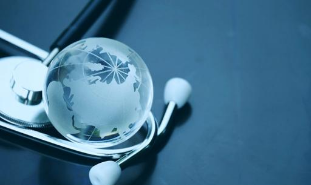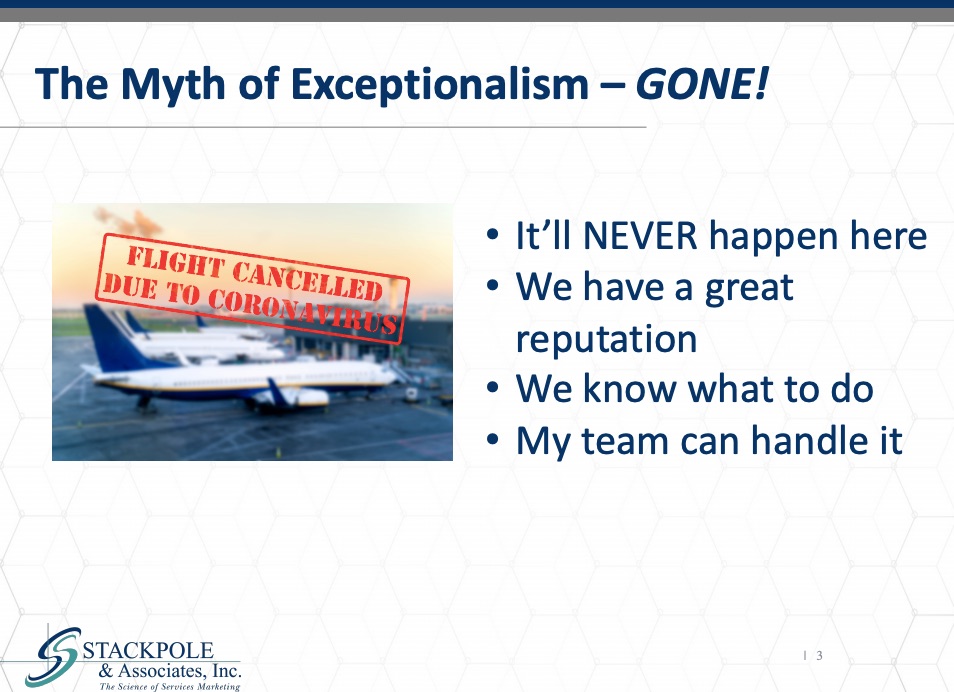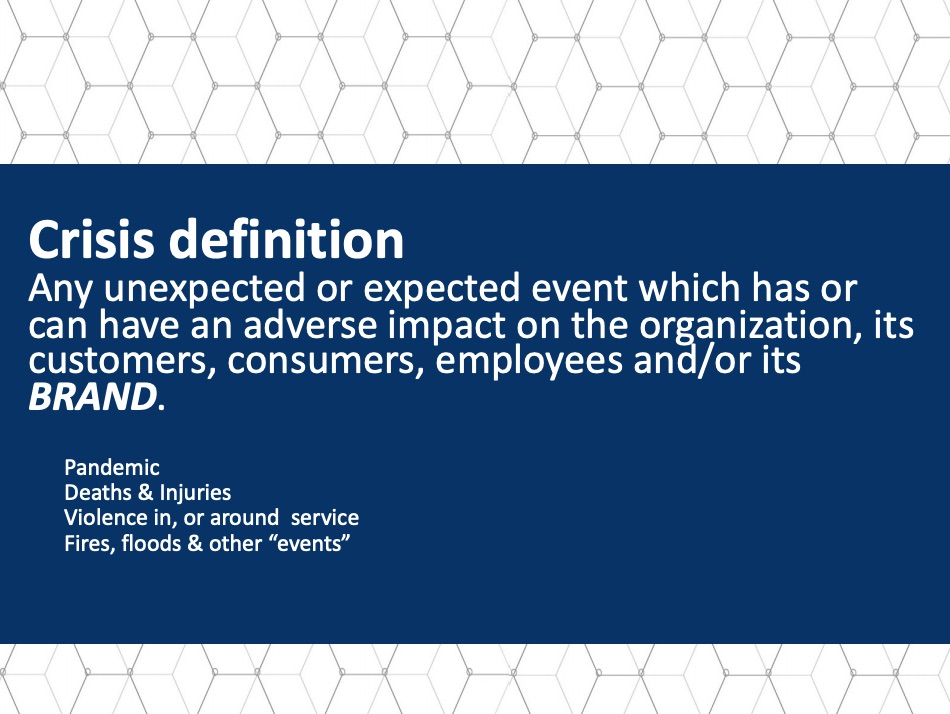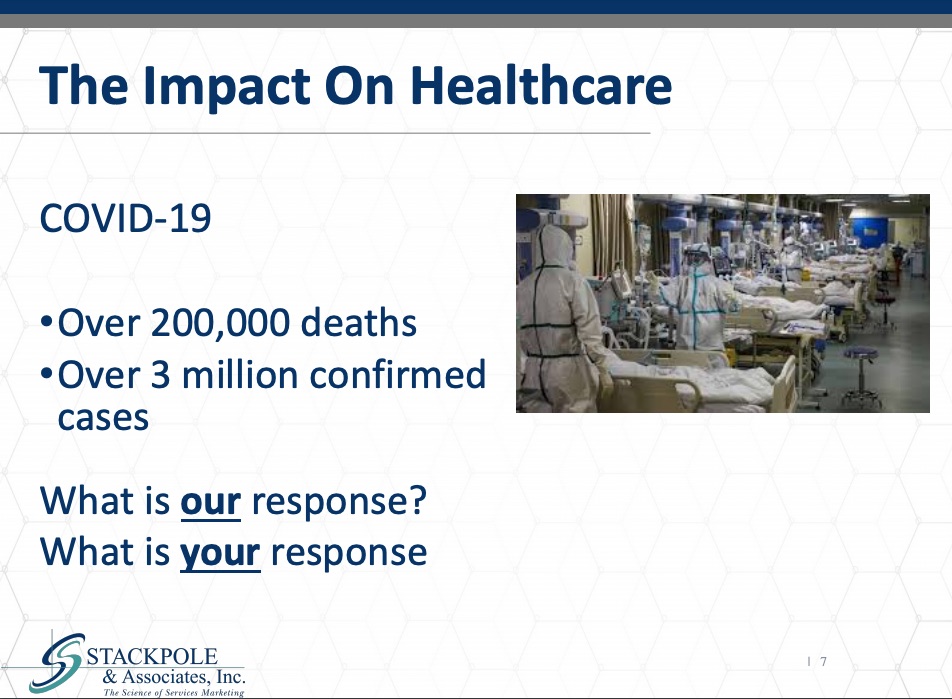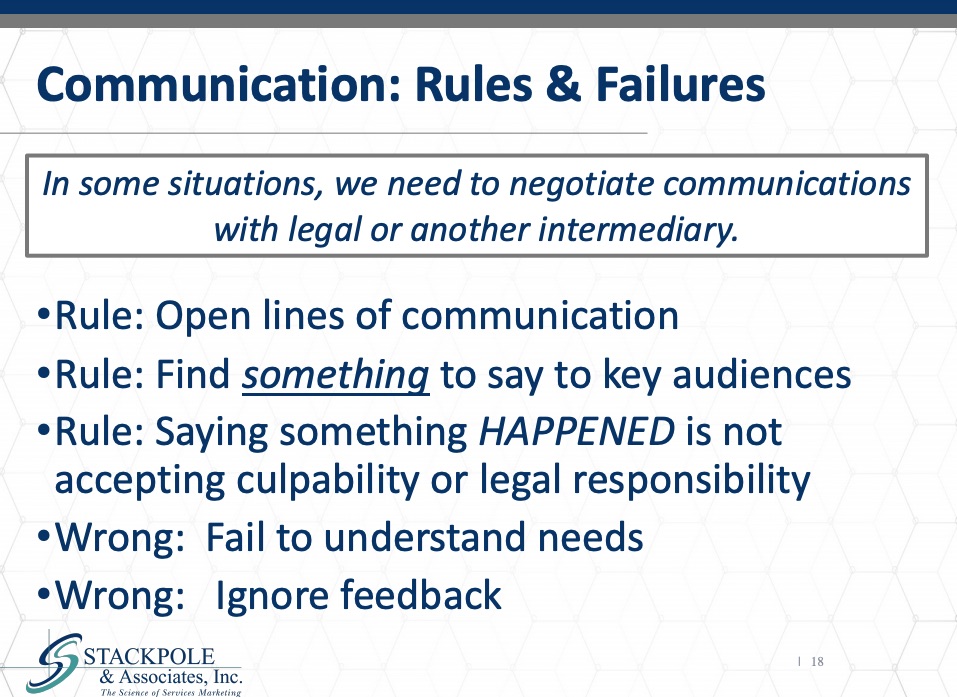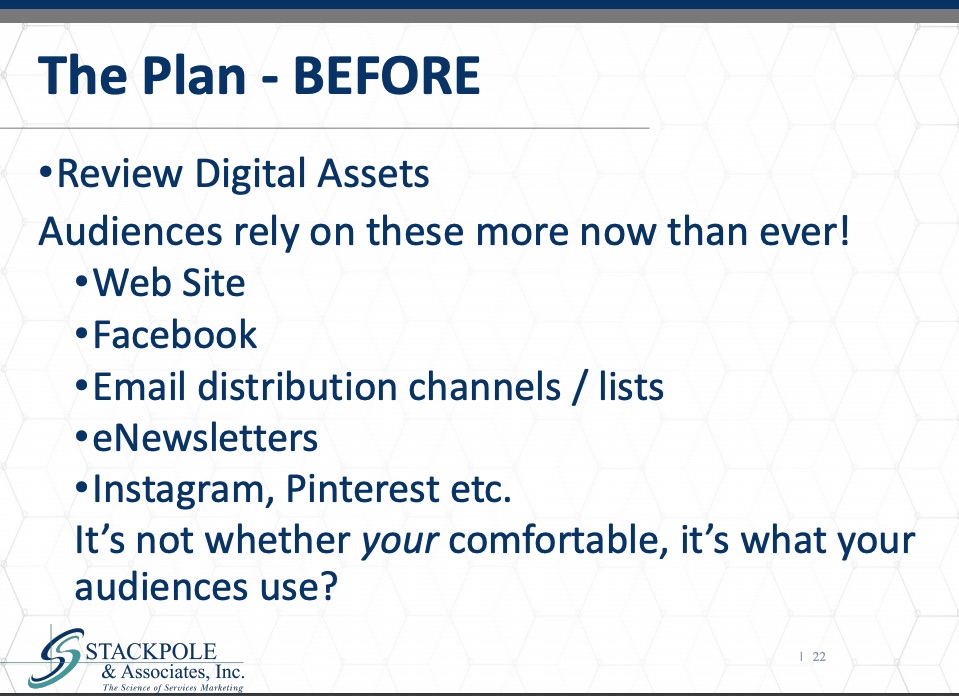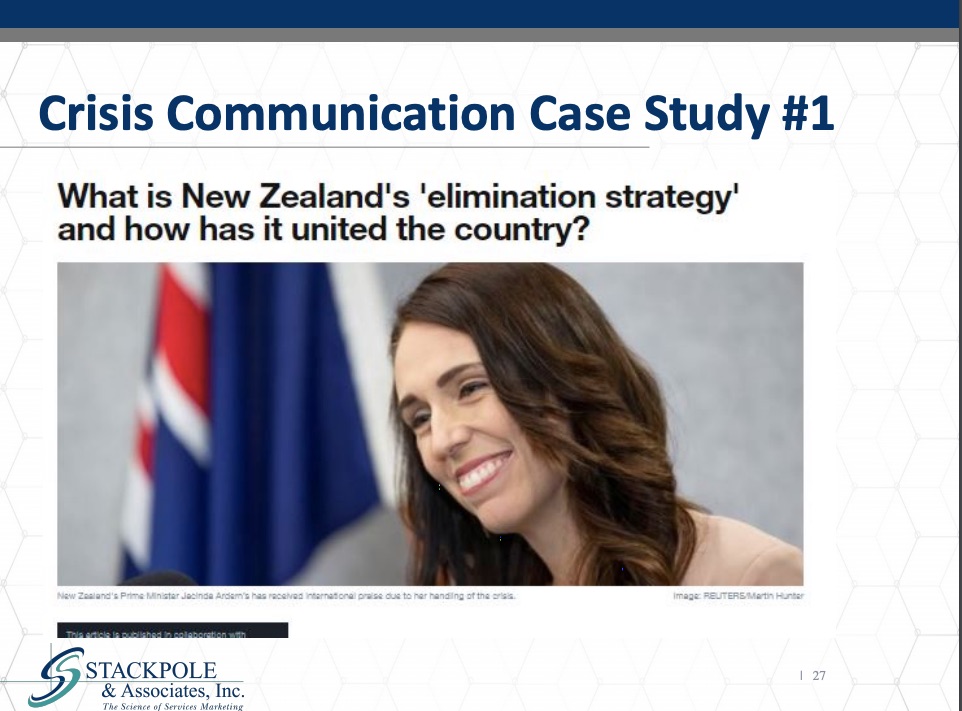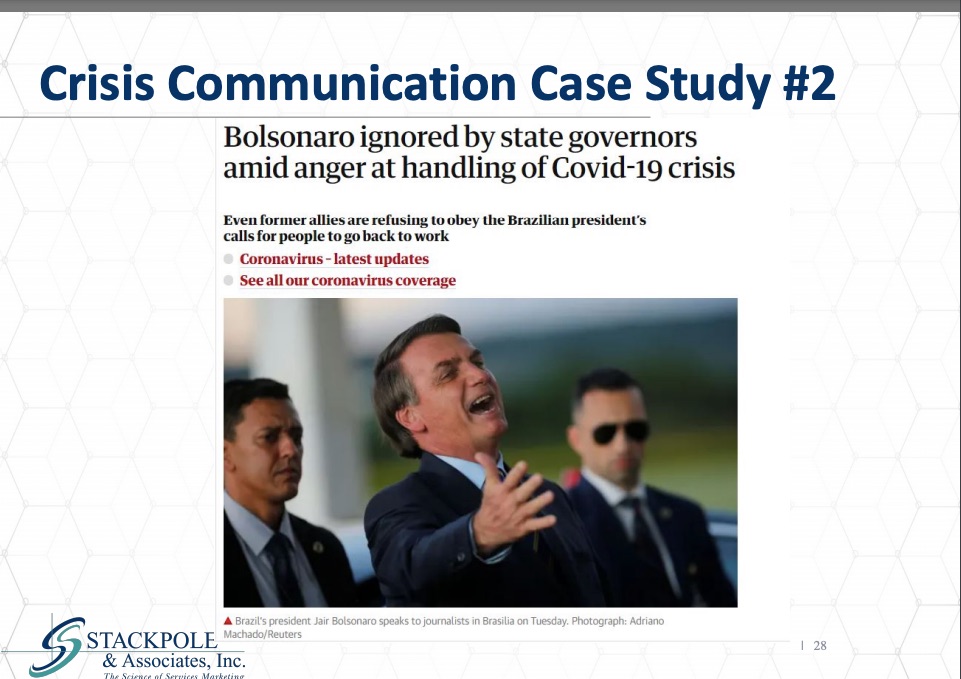Date: 29th April 2020
To watch the recording click here
Register to download the webinar presentation.
Transcript
Health Tourism Grounded: Crisis Communications in Health Tourism
Irving Stackpole
The title of the program is Health Tourism Grounded Crisis Communications. The main points I want to cover is that there are indeed tried and true methods for managing communications during a crisis, and those methods can not only prevent damage to your brand, but they can indeed improve your connections with your markets and your audiences. These systems, these skills can be learned and applied and also to your internal and external audiences, both of which are equally important. More importantly, these tools will help with protecting your brand from damage that’s unnecessarily self-inflicted damage during a crisis.
The first thing that I want to point out is that for all of us, regardless of whether we are destination managers or we are working in health care providers or wellness organizations, there had been this myth of exceptionalism that it won’t happen here. We have a great reputation. We know what to do and my team can handle it. Whatever you may have thought about it, that myth should be crushed and that it’s imperative that not only we have the skills and understanding of what to say when the situation is bad, but also that there be systems in place that can kick into gear and respond during, before, during and after a crisis.
So, I like starting with definitions of crisis. Definition is any unexpected or expected event which has or can have adverse impacts on your organization and importantly impacts on your brand. And that includes this pandemic. But it also includes things that can happen in your location, in your organization, deaths and Injuries, violence, fires, floods and other events. So, the principles I’ll be talking about here apply equally in those environments. And to put things in context as to how crisis communication can take an event and turn it into something that is negative. I want to give you an example of two very similar crises that happened and with two very different outcomes.
Many of you will have heard of the Exxon Valdez, which was a oil tanker that crashed in Alaska. It ran aground and spilled millions of gallons of oil and created an ecological disaster, and it riveted the attention of many people around the world, similar, very similar accident is called the Ashland Oil Crisis, which is where a tank very near the city of Pittsburgh and in the United States spilled three and a half million gallons, three and a half million gallons of oil in a river very close to Pittsburgh. Now, Exxon Valdez is used as an example of what not to do in a crisis.
Most people have forgotten about the Ashland crisis, and that’s because those two disasters were handled in very different manners. In the Exxon Valdez case, the CEO of Exxon sent a series of lower-level managers to the to Alaska to try to deal with the situation. Then when he finally showed up weeks later, he seemed put out impatient and it seemed as though he didn’t want to be there. In the Ashland oil spill, quite the opposite, the Ashland CEO showed up right away to charge, began to brief the press and managed the media through the crisis. Now, I’m not suggesting that this crisis is the same as an ecological challenge like the like what happened in Alaska or what happened on the Monongahela River in Pennsylvania. What’s different here is that Mother Nature isn’t being endangered.
Grandma is that elderly individuals in congregate care centers like nursing homes are disproportionately infected and are having experiencing deaths and illnesses associated with this disease. This is quite personal. The second issue is that our entire sectors are under siege because of this illness. The subject of this webinar is indeed health, tourism and the health sector is under siege, as is the tourism sector. The third reason why this is extraordinarily different is because of the uncertainty associated with it in the case of the Exxon Valdez, Ashland oil and other ecological events, other ecological disasters. It was certainty about when it would be over, when the recovery would occur and what the nature of the recovery would be like in this situation.
So that’s an important those are important differences between historical ecological situations and the current situation with the novel coronavirus and covid-19. Of course, the one of the huge differences is that the coronavirus and covid-19 strike at the heart of our health care systems, wherever that wherever the infections take hold. To date there have been over two hundred thousand deaths and over three million confirmed cases.
My hope here isn’t to talk so much about the nature of the transmission or the illness itself, but to rather talk about how we respond to it. So, what’s our response to this situation, this pandemic, this tragedy? What’s your response? I told I said at the beginning that we talk about the impact on travel and health, and certainly in this slide we can see this picture was taken from a hospital in Italy.
The health care systems in many countries had been stretched to the breaking point because of this disease. But in travel as well, the situation is just as this slide depicts. The number of airline trips has plummeted as locations around the world have closed down travel and put in place restrictions for travelers both into and out of their locations. So, what’s right and what’s wrong about communications in a crisis?
The first rule I’d like you to consider is that it’s important to stop all routine and scheduled press releases, postings and newsletters. Only essential on target messages should be released at this time. I marvel at how I still receive emails talking about the exciting growth in medical tourism, how health travelers are clamoring to get to this destination or that destination, and those kinds of messages are the result of scheduled somewhat routine releases that were set up weeks ago by public relations destinations and health care providers. Unfortunately, those messages not only are inappropriate, but they can also be counterproductive to your brand and to your image. And it’s wrong to say that, well, no one’s going to notice those things because they do. And what can it hurt? Well, it can hurt your brand and damage your reputation quiet on the other side of the coin. A very common problem in crisis communications is to leave the communications to other people. The rule here is that you have to say something.
You, as a destination manager or as a health and wellness provider must speak to the issue that’s at the forefront of everyone’s minds. There are basically two ways to do that. One is for the passive voice where you place information about the crisis, about your response to the crisis, about your activity in your area or in your domain of health care, to talk about what you’re doing and to place that information into channels like your website, your social media channels. I would refer to that as in passive voice. This is what we are doing is also an active voice where you can send messages to your audiences to communicate to them how you or your organization is responding to the crisis, what’s happening in your location, what’s occurring within your organization, how your health care heroes are faring.
These are messages placed into channels actively to communicate to your multiple audiences. Not only that, you’re still there and you’re still working and alive and well, but that you’re responding to this crisis. What’s wrong here is to assume that nobody’s listening because indeed they are. We know from very good scanning of the Internet that activity and Internet channels and in social media channels is very high right now because so many people are working from home and using channels. Many of you are participating in this webinar, and you would not have ordinarily found the time or been able to sit in a webinar in your time zone on this topic. But many people do. It’s an error to think that no one is listening right now. They are. And there are lots of sources for information like your brand, your organization, your destination has a distinct role in many consumers and customers minds.
My hope is that you will reinforce that role by driving home your responsiveness and demonstrating your interest in communicating the essence of your brand to your target audience. Another classic error in any crisis, it’s been the case in this one, I’m afraid is waiting. The rule here is to get up, get it out and get in front of the public rhetoric, the public discussion of the issues. It’s amazing to me how slow the health and the travel sectors in the health tourism domain have been to put information on their websites or in the social media channels. Every channel is important in a time like this, especially digital channels. It’s especially wrong to use the blame game and to make accusations in your communications with your audience about this person didn’t do that or that person didn’t do something.
This organization failed. That’s there’ll be plenty of time for other people to dissect the problem. If you represent a destination, you represent a provider. It’s terribly important that you be as constructive as possible in this time and use messages and images that convey to the extent possible positive images and messages. It’s wrong not to respond. Failure to respond is is leaving a vacuum in the minds of your consumers and your customers, and that’s extraordinarily dangerous. So please don’t wait. Put information, at least put passive information on your websites, in your social media channels about your destination, your organization, your client’s organizations and how they’re responding to these challenges.
The other error that occurs frequently and many of us have been asked to respond to interview requests, asked to comment. There are a lot of opportunities to talk with individuals who are representing media outlets, online print or electronic TV radio. It’s very, very important that we all understand that if you don’t want to see it in print, online, hard copy or be referred to in a television or even a blog post, don’t say it or write it. Whatever you say or write is fair game for any reporter, any media blogger, anyone to grab hold of and use. That can be used to your detriment. Also, with regards to your staff, your employees, your team, don’t wait and wonder what they’re going to say, tell them what to say, give them messages and I’ll be going over the rules for developing messages in a crisis. Give them information about what they can share and how to share. Equally important, ask them when not to share information, both from a privacy point of view and a reputation protection point of view. It’s wrong, therefore, to speak before thinking, and it’s wrong to assume that the media already knows what’s going on, it’s we’re in a situation around the world where the print and electronic media have been consolidating aggressively. There are fewer and fewer news outlets around the world.
So experienced reporters are also fewer and fewer around the world. We shouldn’t assume that someone who represents a news outlet, whether it’s electronic or print or online, we shouldn’t assume that this individual has a lot of experience. We should help that person. I’m reminded of the old adage that we need to have press packets of press packages with background information about our organization and about the sector in which we work. Those packages are still important today, and maybe especially for younger reporters, even more important today. So, assume that the media doesn’t know should be the rule instead of considering the error that the media does, because very often the media will not know. Another important rule is that nobody likes to admit they’ve made a mistake, especially to our staff or the outside world.
That’s so critical to building trust and restoring your reputation at a time like this. So take responsibility and in this in this message I say take responsibility for something. It’s an error to hide behind others to say, well, I can’t talk about that right now because the lawyers are reviewing it, or I don’t want to talk about that right now because there’s privacy issues involved. No, you talk about something. Give your clients information that they want and that they need in a particular way. You need to figure out what it is you can say to your audience and be able to say it honestly and clearly, not to hide and not to delay and not to muddy the waters in particular. I’ll be sharing with you two case studies, which I think highlight these points.
The issue is to take responsibility, we are responsible in so many ways for our audiences who are responsible for those who work with us, we are responsible for those who support us. We’re responsible to our customers. We’re responsible to our consumers, and we’re responsible to our colleagues to demonstrate and to show through what we put online, what we put into the media, what we have to do to show them that we’re taking these matters seriously and we’re responding clearly, intelligently and ethically to this extraordinary crisis. With that being said, another one of the rules is never underestimate the ability of someone on your team to do something unexpected under stress.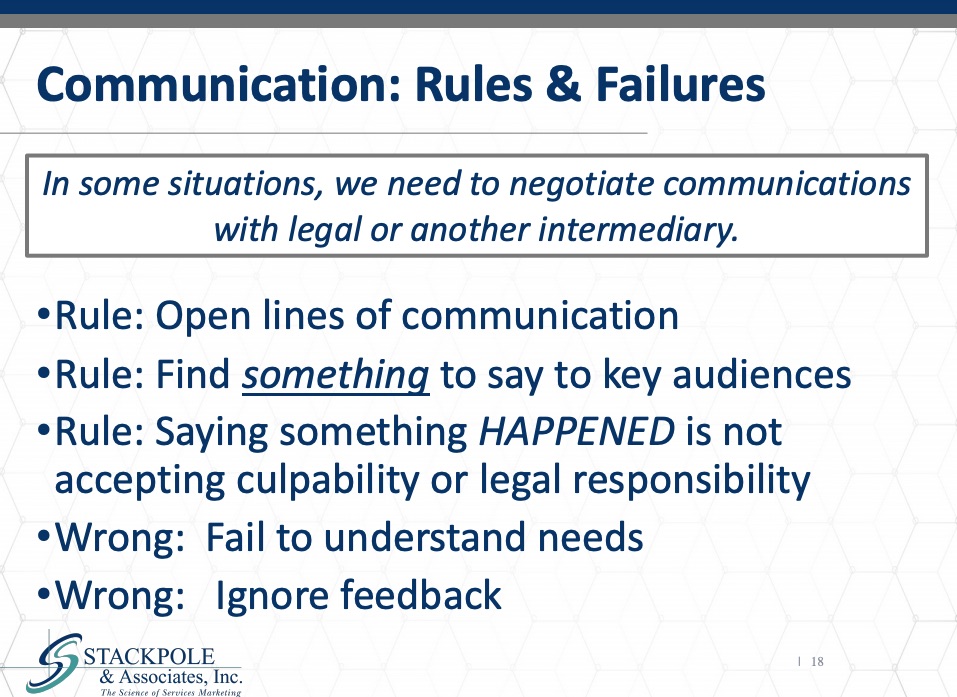
Everybody is under stress. So, the rule here is to be flexible, respond to all new events and information, and it’s wrong to take to fail to take rumors seriously. Rumors and misinformation are extraordinarily dangerous, which is why you see in the media there’s scrutiny going through public leaders and business leaders, statements about the situation in their destinations, the situations within their organizations.
People are going through these statements very carefully because the trustworthiness of these statements are critical to the sense of well-being, that individual’s experience and to what we do. Do we wear a mask? Do we go out? Do we not go out? What level of physical distancing? When will it be safe to travel? These are extraordinarily important, and rumors and misinformation are dangerous. Going back to the point I made earlier about passive communications and making certain that you have information on your Web sites and in your social media channels, that’s accurate and reliable and authoritative. This is one of the reasons that’s so important is to be able to refer people to information that’s authoritative and will dispel rumors. Rumors are dangerous at a time like this. So it’s important that we understand the communications needs of your audiences and that you make accommodation for them by putting information on your website and your social media channels. That’s accurate, reliable and authoritative. Stackpole and Associates has done this in virtually every organization can and should take similar steps. Another important rule for communications, especially in this particular covid-19 crisis, is that we need to make sure that the consequences of our statements are considered. One application of this, that this crisis is not going to be over for an awfully long time. I say here it’s never over for someone.
Many of us know someone, even someone close to us who has become ill or who has been seriously disjointed because of this illness, separated from family, separated from loved ones, uncertain about the fate of loved ones. There is never an opportunity in this environment for us to say it’s done. Let’s go home. No victory dances, no being dismissive. Oh, it’s going to go away. It’s all going to be fine. Don’t worry about that kind of pandering, dismissive language in our communications, both verbal and certainly in print, on writing, on our websites and in media, but cast us as being insensitive and unaware of the fact that two hundred thousand people have died in three. Over three million people at this point have been diagnosed with the illness. This is not a time we will not in any time, any time soon have an opportunity for a victory dance. That needs to be taken into consideration in our crisis communications plans and methods here during the covid-19 crisis.
Now, in some situations, we need to negotiate communications with lawyers or with other intermediaries, our insurance company or others, but the rule here is to maintain open lines of communication, in fact, to be actively communicating to as broad an audience as possible, even those audiences who have been hurt. We the rule again here, similar to previously, is we need to find something to say to them and I’ll give you a formula for how to do that, saying something has happened, someone has become infected, the infection rate has increased, is not the same as accepting legal culpability or responsibility for what’s occurred. But it’s extremely important that we understand the needs of our audiences and that we respond to those needs with transparency and candor. It’s very dangerous to ignore feedback, especially the kind of feedback saying, well, I can’t find out what’s going on. They won’t tell me. I see in the newspaper statements by family members saying, well, I can’t find out what’s going on. They won’t tell me that’s outcome to be absolutely avoided and can be avoided with active communications channels.
While in some situations we need to have the lawyers and insurance brokers and other people coaching us, there’s never there’s never a situation where we have to be completely silent with our audiences. Now you’re getting the sense that so much of crisis communication is involved in or critical preparation is critical and indeed that is the case. Who says what to whom and when needs to be thought about beforehand? So I’m going to go through some of the preparation in the hope that you, the audience and those whom you share this webinar recording with, that you can use these guidelines for the current situation and for future situations as well. They’re equally applicable and preparation, preparation and preparation is so important before what hits the fan.
Before the crisis, we need systems in place to say who says what and to whom. Where the phone numbers are for not just the police and the fire, but the other emergency services where the emails are, the phone numbers and within an organization, if you’ve got if you’re a provider or you’ve got a busy destination management organization, those phone numbers need to be in everybody’s phone. They need to be close to every phone, every shift, every location. We need to develop scripts, scripts for all of the people who are in any way going to be called by or contacted by anyone in the media or anybody from the general public. The best method, the best model for communications in a crisis is drafted in this script below, and it’s paraphrased as though it were a phone call, but it would be equally effective as a response to an email. It basically says thanks for calling. I’m afraid I can’t comment on your question. Give me your contact details and I’ll be sure to pass them on, not to just anybody, but to a particular person, because the person answering the phone will know in advance that all such contacts are to be directed to Mrs. Flynn. So be sure I’ll pass them on to Mrs. Flynn. We’ll be in touch with you as soon as possible. Thanks for your patience. In a really sophisticated way, the person responding might even ask, do you have a deadline for this story or are you working on a deadline for this so that I can share that information with Mrs. Clinton?
These this is this responsiveness will be we’ll make sure that in the media you don’t read. Well, we tried to contact ABC Hospital, but no one was available for comment because you have made it clear that someone is available, and someone will get back to you right away. Before what else, before this all suggests that there is a plan in place and we can be working on our current crisis and planning for the next one in very constructive ways, first of all, lists of local media, radio, press, don’t forget the freebies, the penny papers that are distributed in a local marketplace, areas at the grocery store or the Degas or the the hairdressers. Those freebies are very, very important in newsletters, social media, Google alerts, et cetera. And if you don’t have a Google alert set up, I hope you will I hope you will just go to Google and type in alerts and go ahead and set up Google Alerts for a variety, your name, the name of your organization and the name of your destination. You can keep track of what’s being said in the media about you, your organization and your destination. It’s very important, if you can, to build these relationships before the crisis occurs.
Now that the crisis has occurred, this is also an opportunity for you to build relationships not only with your staff, your customers and your consumers, but also with your media, again, as being an honest, transparent and direct source for authoritative information during the crisis. That relationship can be extraordinarily important for you going forward. It will build trust, build trust in you and build trust in your brand. And of course, as with any crisis, the key is practice. During this crisis, many of us are getting a lot of practice, more practice than many, many folks wanted to have. Before it’s really important to review your digital assets, that means looking at your Web site, looking at social media and evaluating how effectively these are not only reaching your audiences, but how effectively they’re representing your brand. Audiences rely on these now more than ever, your website, Facebook, email distribution lists in newsletters, Instagram, Pinterest, whatever it is. And it’s not whether you’re comfortable using these channels.
It’s what your it’s rather what your audiences use during a meet, during a crisis, during a crisis communications time such as we’re in. It’s tremendously important that if you’re contacted by an editor or publisher, if you’re called every media in court, every single one. What a paper, journal, radio, TV station. Did you say you were with write it down and reply to every media inquiry, even the ones which you discovered through your research are illegitimate. That warrants a response as well, not the same as inquiries from legitimate sources. But every media inquiry needs a response.
Failing to reply invites speculation, speculation about the worst. And again, I’ll say you can always say something. During the crisis, you want to create external talking points, it’s terribly important that in all of your messages, all of your verbal communications and all of your print communications, that you do not use the first-person singular eye because frankly, it’s not about you. It’s about your audience. It’s about the situation. I’m going to suggest that we together adopt the process of using what I call I don’t think I coined this the sandwich. And it’s basically three things. One is, you see what your vision, mission and values are.
It’s Stackpole and Associates. Our first responsibility is to measurably improve the relationships between and among clients, consumers and health and seniors, livings organizations. That’s our mission. I say that first, if you’re a provider at ABC Hospital, our first responsibility is the safety and well-being of our patients and staff. That’s where you start. You start by saying what your principles are.
Second, you talk about the situation, about the response to the question that was posed to you. We’re deeply concerned about the covid-19 incidence rate and are working feverishly through our health care staff, our heroes on the frontline, and exploring every option to suppress the curve. That’s because our hospital remains committed to the safety and well-being of our patients and staff. We want to thank families, fire officials, law enforcements, politicians for their dedication and assistance at this challenging time. Any of you who have listened to a trained politician or business leader talk about a difficult subject like covid-19, you’ll recognize this pattern in their communications. They talk about the mission vision values. They talk about the problem, and then they talk. They repeat the mission, vision and value, creating a sandwich in response. Similarly, the internal statements are sandwiches as well.
They have a few more layers to them because the internal audiences, your staff, your board, your investors, they need more they need more information. This is how to structure it. Our first concern is the safety, health and well-being of our staff. This occurred three more of our front line. I’m making this a paraphrasing. Three more of our front-line workers have tested positive. We are quarantining, investigating, tracing, tracking. Next, during this difficult time, please go to me, go to Mrs. Flynn for any questions or further information. Here’s the point refrain from commenting outside of ABC because of its privacy nature and because we want to deliver the best, most complete information possible, and if there are rumors circulating or partial stories circulating, that will make the situation far more difficult for our families and our friends at this difficult time. Thank you for your cooperation and patience, repeat the vision, the vision, mission values our first concern and then finally call me at any time. This means that the leaders within the organization who are stepping up and getting it out, getting in front of or taking personal responsibility for communications at a difficult time.
So now I’d like to share with you two recent case studies regarding the covid-19 pandemic that I think will illustrate the impact in the media of effective and, frankly, ineffective communications techniques. The first of these is New Zealand’s prime minister. Now this was taken, I think, from The Guardian, the headline, what is New Zealand’s elimination strategy and how is it united the country? I think you’ll all agree that this image, whether you agree or disagree with the strategy of New Zealand, New Zealand prime minister, regardless of what your political orientation is, I would argue that this is a constructive headline.
That is to say, it’s positive and the image of the prime minister supports the headline. So these are constructive images and constructive language at a difficult time. The story goes on to talk about how the quote unquote, elimination strategy has been deployed and how she’s taken to unite her government and her public health professionals and the country. Now, where did the media get this story? The media got that story from people in the government. This was all very carefully established. And even information that wasn’t necessarily flattering was made available to the media for the development of this story.
On the other hand, I’m going to offer you another example, a case study. Number two, this is the president of Brazil, jailable scenario, whom I know many of you understand, contracted the novel coronavirus and had symptoms of covid-19. This headline uses the word his name and then ignored by other people in power amid anger at handling of covid-19 crisis.
The headline itself is quite damning and you’ll see that this picture conveys a message of disregard and boldness even. These this headline and this image conspire to create or portray a picture that’s dramatically different from this headline and this picture. The individuals in both governments and both political groups had an opportunity to manage these messages. And this is how they handled it. I would make this I would make the very firm suggestion that this is a way better, a far better use of the media in a crisis than this. Let’s move on to after the crisis, after the crisis is a time, we can’t really be sure about some general ideas, and I hope you’ll join us on May 9th when we talk about the road ahead for health tourism.
The state is still in crisis, communications here is somewhat reflective, determine the extent of the damage, if necessary, a repair plan and you will know you need a repair plan if your image, the trust in your brand is damaged. You’ll learn that by asking your audiences. From whom you will ask feedback, you’re going to help correct misinformation, execute the repair plan and say thank you, thank you to your audiences for their attention, for their staying open to you during the time during the time of the crisis. The question here, this is a bit of a mini audit for your preparation for a crisis. Do you have a designated crisis team? If not, why not only because you haven’t put one together? Is there a clear team leader and backup because, you know, stuff just doesn’t happen nine to five Monday through Friday? Who’s responsible for communications and does everybody know who to contact? Do you have a notification process? In the old days we used to call them phone trees. These days we can call them email distribution lists or text lists. Have you considered which staff members own relationships with certain audiences? And are they on board with the communications program that you’ve got?
This all boils down to does everyone know what to do. Do we know what to expect, we know to expect the unimaginable very few people outside of a few public health global health professionals knew in advance that this was coming. We can prepare, we can plan. That means getting digital as digital as we can, just like this webinar, then execute and listen to your audiences. In conclusion, I suggest to you what George Bernard Shaw said, single biggest problem in communication is the illusion that it has taken place. I want to thank you for participating and I’m delighted to take your questions.
Questions
Question: Would it be appropriate to talk to our audience and helping this type of environment prevent giving false hopes of one problem or wanting to prevent Asian countries under these circumstances?
The notion of false hope is what’s essential, that’s the operant element in that question. For those of us who are optimists, we want things to happen quickly and we expect that things will happen faster than they usually do. Those of us who are realists, on the other hand, are prone to overestimate how long it will take for example, for travel restrictions to be lifted or for entries and exits out of a out of a destination to resume or to back up. Here we need to be extremely balanced. We need to not only give reason for hope, for example, saying something like that, the government will announce, we anticipate the government announcing loosening of travel restrictions on or before May 8th which I think is going to happen here in Lisbon. So, we can say that. But we need to also say, however, however, we are not, as no one is quite sure how these restrictions will be lifted. Whether there will be quarantines associated with them and how those changes will be implemented, over what period of time, so we need to be careful if even if we’re optimistic. So, the issue of faith and trust is what’s at stake in our communications with our audiences, customers, consumers and our staff at this time.
Question: Which market will start first adding?
Historically, the health travel markets were heavily regionalized, and folks involved, folks in Asia know that. Folks in Europe know that. Folks in the United States understand that as well. It’s hard to say because it’s hard to say how which markets will start up first, because it’s hard at this point to recognize how restrictions and easing will be sequenced. So, it’s very likely, based on the biology of the virus, that there will be easing of travel restrictions and then as some new infections occur, renewed restrictions on those travel requirements, travel opportunities. We’ll go back and forth for a bit. So, it’s very difficult to say. What is sure, however, is that the images that have been burned into our minds of overwhelmed hospitals and other images that have been broadly distributed, they will linger with consumers and referral sources for some time to come and influence choices going forward.
Question: Will there be any changes in the regional flows of health tourists?
I believe they will be based on changes in opportunity, so there will be opportunities for certain destinations to establish themselves as safe or safer alternatives to a destination that previously had enjoyed quite a robust amount of health travel. There will be opportunities for destinations that hadn’t really considered themselves to be strong, but now have gotten through the pandemic quite well. Thank you very much. They have a legitimate opportunity to establish themselves as new, more compelling alternatives for those looking for treatments and procedures and even wellness activities after that, after the crisis lifts.
Question: Do you think even if travel restrictions are lifted, patients will be able to travel earlier than 2021?
What’s becoming clear is the as I said earlier that the word that comes to mind is the imbalance or a synchrony of this pandemic. So. Places that are going through the curve that are on the other side of the curve of the rise in infections, the rise in new infections in transmission, what’s called the ah, so those who are on the other side of that, they can be able to ease their travel restrictions. Earlier, the question about which consumers will want to go there is a very subtle question, and I don’t believe there’s a single flat answer.
I believe that individuals who are adventurous individuals who like the political figure I have the picture of earlier who seem a little bold and indifferent to facts on the ground, these people may be very willing to travel very early in the recovery, but that’s not where the bulk of the market is. The bulk of this market will want assurances, will want comfort and will want information, which is why communications in at this time is so central, so centrally important.
How these restrictions get eased and where and when some of this slow starts to occur will be pivotal to watch and critical for the next stages, not only in that destination or for that provider, but for other destinations and other providers.
Question: So many people are talking about local travel as the first tunnel that will open. Any comments that.
Yes, I think that’s absolutely true. There was a published study from the United States that was done recently that showed that most people said that the safest place they felt safest was their home or their office was their car, which is pretty interesting because a lot of hard surfaces in your car, they can become infected and transmit the virus. But in any event, people have a sense of security in their automobile. Part of that, I think, is because you’re driving it, you’ve got physical control. In a time where you have control or so little, it’s important to feel control and you feel that control when you’re driving your car. So, yes, I believe that there will be new boundaries, new marketplaces, areas redefined based on things based on psychological and psychographic factors such as safety and drive times and that sort of thing.
Question: What do you think about the attitude, openness and readiness for traveling of health tourists? Would it be a leading motivation?
So this is a question about the psychological psychographic of the health care consumer and just as with every other market, there’s no one psychographic, it’s several melded into one. What I alluded to earlier at certain individuals who are perhaps more adventurous individuals who have a different risk profile, individuals who are willing to tolerate higher levels of risk. These individuals will be willing to travel and consume health, wellness, dental services in a remote destination sooner than the people who own two insurance policies when one insurance policy would be fine. Thank you very much. Those people are truly risk averse and their willingness to accept a health tourism solution that I believe will be truly impacted for quite a long time. It depends upon the audience. It depends upon the profile. I don’t believe that that question can be answered with one response. I think what the question points out is the need to finally in this in these markets to do more subtle analysis of consumers attitudes. It’s been a real gap in the research and understanding of the health travel markets. That is to say, what are the motivators, inhibitors, obstacles and barriers to consuming at a distance?
Question: What do you think that we can use good work around Covid19?
Absolutely, whatever you were doing as a destination or as a provider that is constructed, that’s in compliance with best practices, that perhaps is defining best practices. If your hospital lab has created innovations around testing that has accelerated that testing, those results being available, that has created some novel way to develop or distribute personal protective equipment, these are things which need to be media forward. These are things which should be pushed to your audiences, not only passively on your Web site, but communicated to your specific audiences as well as to the general public. So, yes, if you’re doing good work, we all want to hear about it, because these are these are the rays of sunshine that break through the clouds.
Question: What will regain faith of medical travelers? Post covid-19.
I believe in its entirety, but the answer to that question will be written by some of the people who are on this webinar and others in these markets. The first thing will be success reported of the initial travelers. If there’s groups of travelers that go to a particular destination and. Once the travel restrictions are eased and half of them get sick, that spells trouble. What will encourage them to go is confidence that the environment is safe, that precautions are in place. I know that there are a number of innovative organizations that are looking at developing standards of cleanliness, standards of protocols that will offer some basic level of those assurances. Credentialing agencies, accrediting bodies like team also working on those things. I believe that that’s going to be a very important part of this. But the second equally important, perhaps more important part will be early success. Early success will encourage other others to to go ahead and try early problems will create further resistance.
Question: Do you think it’s possible that some governments will stop high risk patients from visiting that country for medical treatment, for example, of cancer patients, heart surgery, etc., as these patients would be more susceptible to becoming infected with the coronavirus?
So that’s a very detailed and specific question, I can only tell you what I would hope. I would hope that governments, especially Portable governments, governments that have control over a major transportation portal for health travelers, I would hope that they would institute safety and monitoring so that regardless of the individual’s condition or reason for traveling, that if they were if they weren’t well, if they had a temperature or their other vital signs weren’t quite right, that they would be quarantined.
There will be no doubt certain the high acuity cases where individuals will be transported under extraordinary security and safety protocols from one location to another location in order to receive care. I’m sure that that will occur. But that’s the exception and not really the health tourism market. That’s the exceptional situation. What we need is we need governments to deploy, create that and deploy effective screening procedures and we need providers who will comply with and work with those standards in their own institutions.
Question: Travel insurance companies have now put covered clauses in their policies. Plus, customers may wish to travel for health tourism. Do you think these types of clauses may put them off, especially if they are likely to be further waves of restrictions?
Well, that’s an extraordinarily good and detailed question, and I would pose that question rather to the insurance representative. The insurance companies exist in order to make money for their shareholders. And the way they do that is by carefully excluding services on which they know they’re going to take a loss. And in the case of travel insurance, the lack of a clause for covid, they allow an individual to travel and receive payment for care. But I doubt that they will be. I doubt it will be very long before. Let me say that positively. I am sure that many insurance companies are scrambling to add riders on their insurance policies to color coded to exclude those charges if the individual travels knowingly, symptomatically, or if the destination allows that individual without proper screening.
Question: What would be the impact of the healthcare industry after covid-19 worldwide?
We’re going to have an extraordinary rebound that will be developed to capacity that will have to be taken offline, the emergency system as emergency hospitals, the public hospitals, these will have to be taken offline. The second thing is that there will be large. Pieces of the healthcare system, which even if the health care system isn’t a private enterprise in your country, I’m thinking primarily of the United States now will be large parts of the health care systems in the United States and in other places where because of the drop-in non-urgent scheduled surgeries and procedures, because of the drop in, that they will have extraordinary debt and some of them will not survive. I would expect that there will be hospital closures and clinics may emerge and there will be other post shock consolidations in the health care sector. There are other parts of the health care sector that will be even more or less because of the investments, because of the development of improvement in their reputation and how they handled the crisis and what was said about them in the crisis. It’s highly specific. What will occur is highly geographic geography specific.
Stackpole & Associates is a marketing, research & strategy consulting firm focused on healthcare and seniors’ services markets. Irving can be reached directly at istackpole@stackpoleassociates.com.

